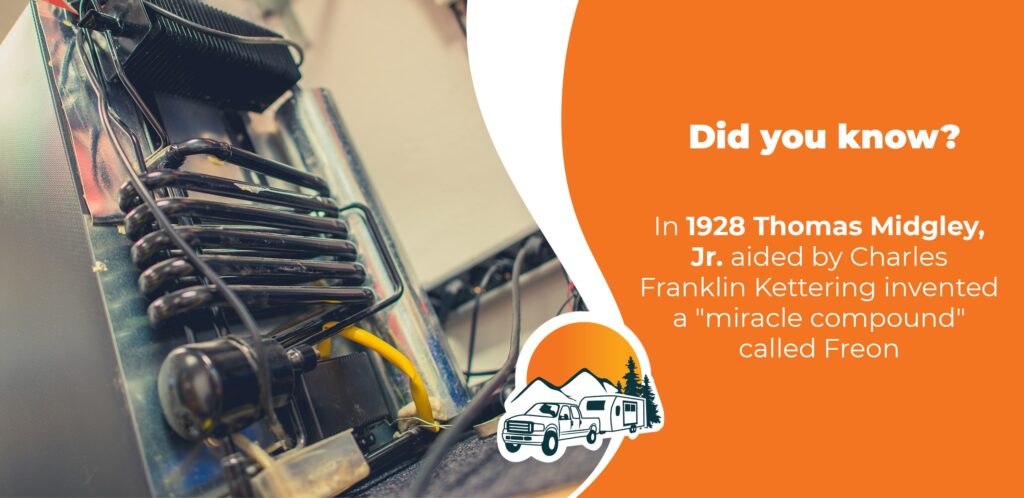It is summer season, the schools are off, and the setting is precise for an excellent RV trip with your family. Hitting the road this summer will be even more enjoyable because most families were limited to their homes due to the perils of the COVID-19 pandemic. We finally have some stability, and the mood is set for an excellent RV vacation.

As temperatures soar during the summer season, you will want food items and other edibles inside your RV fridge to remain cold. Your RV fridge will struggle at times to get the right temperature running. We know nothing can ruin your vacation more than a fridge full of spoiled food.
Don’t start panicking yet, because we have a good set of instructions you can follow to make sure your RV fridge keeps working at an optimal level at all times. Stay with us and fasten your seatbelts as we take you through all the details regarding keeping your RV fridge cool.
Features and Benefits of a Compact RV Fridge
Compact fridges are quite the rage today and are extremely popular with urban dwellers that live in small apartments by themselves or travel a lot. About the standard fridge, compact fridges offer several essential features and benefits. These compact fridges come in handy when a standard-sized refrigerator isn’t an ideal choice for you. This requirement is often the need of the hour for RV travelers.
To begin with, convenience is an indispensable benefit you can enjoy through a compact fridge of your own. These fridges can be effortlessly shifted from one place to another and don’t prove to be a menace when shifting places or changing cities. Additionally, since they come with space-saving designs, you don’t need a dedicated space for them. These fridges sit well with today’s space-saving lifestyle and trump the rather large and awkward presence of traditional fridges. You can also place your RV fridge on a small shelf in your RV.
Due to their small size, there are also multiple uses for a compact fridge. You can use it in your bedroom for beverages or in your office for cold ones. You can also take these fridges along with you on camping trips.
If your RV has a fridge of its own, you would want to check and read through the manual on display. You cannot troubleshoot or solve problems you face with your RV fridge until you know the root cause. Most RV fridges pre-installed in the vehicle run on absorption or compression standards.
Compressor fridges are more similar to home fridges in nature and do better at keeping food inside the RV cold, even during hot temperatures. The compressor inside the fridge follows the same principles as that of your RV ac, with the slight difference that it has a smaller area to cool.
Some RVs also come with absorption fridges. These fridges are managed through electric or propane energy. The fridge mixes ammonia with the refrigerant to create the perfect mixture, which creates a cooling sensation when boiled. The boiling point for ammonia is -16 degrees Fahrenheit.

Dos and Don’ts for Managing RV Fridges
Now that we understand how the different types of RV fridges work, it is time that we look at the dos and don’ts travelers should follow for running their RV fridges. While operating the refrigerator, you should keep instructions in mind so that the cooling is maintained and you aren’t starved for cold edibles and water on your journey. Additionally, poor cooling inside the fridge can also lead to spoiled food.
- Do not use the propane setting inside your fridge if the RV isn’t leveled correctly. You can read our article on balancing your RV by dropping bricks to ensure your RV is leveled.
- Consistently maintain and check on the evaporator coils or fins regularly. You want to keep checking on the fins frequently so that any problem is found in its infancy and then averted for the future.
- Always ensure that you aren’t storing hot food inside your RV fridge. You should ensure that the food has cooled down before adding it to your RV fridge for storage.
- You should regularly check the freezer inside your fridge to check for ice build-up.
- Make sure that your food is as cold as possible to avoid spoilage.
- Never shut your fridge off when you still have food inside of it.
- If you turn your fridge off after a long while, make sure that you leave it on for at least 12 hours before adding some food inside.
- Make sure that the fridge isn’t attracting direct sunlight. Keep it at a side that isn’t attracting direct sunlight.
- Only open the doors of your fridge when it is necessary. Unnecessarily opening and closing the doors of your RV fridge will lead to a waste of cool air inside it.
- Never stuff your RV fridge with extra food that you don’t need. The style of most absorption fridges is dependent on the thorough circulation of air.
- Always know of the coldest spots in your fridge so that you can place ice cream and other treats on it.
- Ensure you have an extra compact fridge available if you travel in the summers.
- The gasket around your fridge doors should be clean. The gasket helps keep the cold air intact inside the fridge and ensures no leakages.
- It would help if you cleaned the outside panel of your fridge regularly to keep infestations at bay.
How to Defrost Your Fridge and Freezer?
Over time you will see an accumulation of ice on the back of the fridge, where the sensors are located. This area is crucial for air movement and should be checked. If this area isn’t working correctly, you need to ensure the correct temperature inside the freezer.
You can defrost your RV fridge using a heat gun, a hairdryer, an ice cooler, and a small ice scraper.
The process for defrosting your fridge is mentioned below:
1. You should start the cleaning process by turning off the refrigerator and removing all of the food that is currently present inside the fridge. You should then keep your food outside where it is safe. Make sure that the food is completely covered.
2. Carefully use your heat gun or the hairdryer in the area. Ensure that the face of your accessory is pointed towards the sheets of ice. You can also use your ice scraper to scrape away large chunks of ice.
3. Take your towel and wipe away the water that drips as you continue to thaw the ice on the fridge. You can take large pieces of ice and place them inside the shower to melt.
4. Once you have removed all solid chunks of ice, you should move towards blowing the hairdryer on the fins. Ensure that you don’t scrape the sensors or the fins, as they are sensitive and can pick up damage easily.
5. Gently place all of your food items back into the fridge. You can also clean the sides of the refrigerator during the process.
6. Ensure that you check the temperature settings to set correctly.
7. Repeat the defrosting process from time to time whenever you see an accumulation of ice inside your fridge.
Ways to Improve RV Fridge Efficiency
A fridge is crucial for your RV trip. While most fridges look pleasing to the eye, they are incredibly high electricity consumers. This means that you might be burning more gas to keep them running during the day in your RV.
So, how is it possible for you to keep the costs down and use electricity efficiently while using your fridge? Here we mention practical tips on limiting electricity use with these efficient methods.
Here are some ways to keep the electricity usage down:
Turn Door Heaters Off
You can save a lot of money on energy by turning off the heaters located on the doors of a fridge. Only use the heater if you see a lot of frost and water dripping from the front. Since it is just your family inside the RV, you don’t have to clean the ice again and again.
Ensure Air Circulation
It would help if you looked at the location of your fridge because the air circulation near the refrigerator has a vital role to play here. If your refrigerator is located in a tight corner, it is possible to heat up and take way more energy than usual.
Make sure to leave enough room for air to circulate and the refrigerator to work without any trouble. Finding the perfect location in the RV can be a tough job, but we suggest leaving some space behind the fridge grills for it to work.
Ensure Regular Maintenance
Fridges that are not regularly maintained tend to take up way more energy than others that are regularly maintained. In such cases, it is necessary to periodically maintain your refrigerator and ensure that it meets the quality standards you want.
Only when the fridge is in optimal condition would it give a desirable performance. A refrigerator that isn’t in an optimal condition would take up a lot of energy.
Efficient LED Lighting
Since lighting is essential inside your fridge to make it easier for your family to locate the food items, when it comes to lighting, you should go for the most efficient option in LED lighting. LED lighting is best for your RV fridge as it takes the heat out of the picture and provides a good, relaxed environment.
Keeping all your food and beverages cold is necessary for a good RV adventure. A good fridge that is regularly tuned will help increase efficiency and make sure that you have cold beverages and hygienic food available to you.
And That’s a Wrap
The tips mentioned in this article will help you get the best out of your RV fridge and ensure that you improve electricity usage. Following these tips will help keep your RV fridge cool, regardless of how hot your following adventure camping site is.







